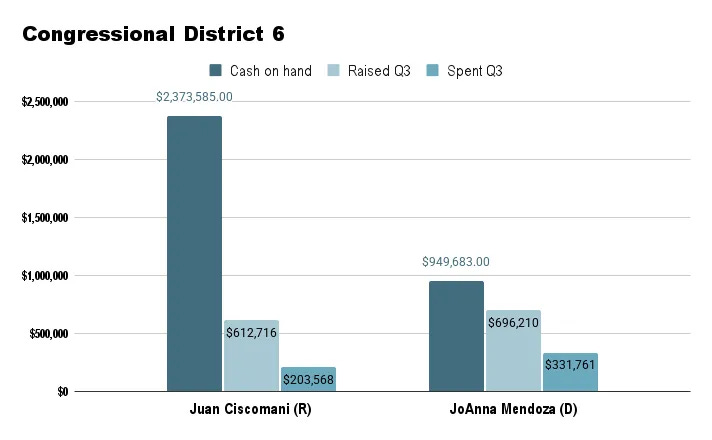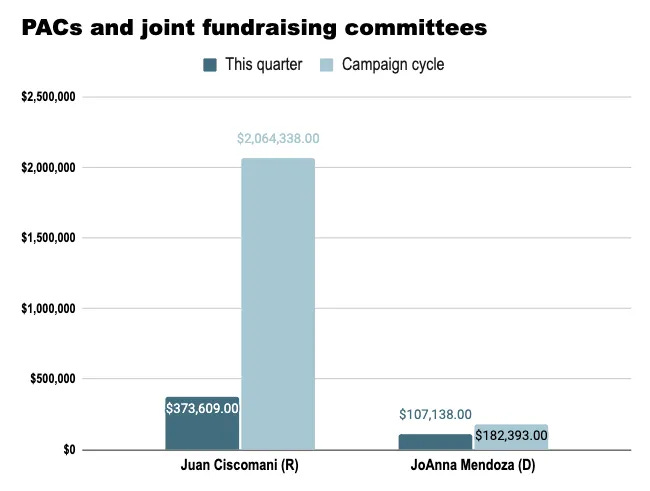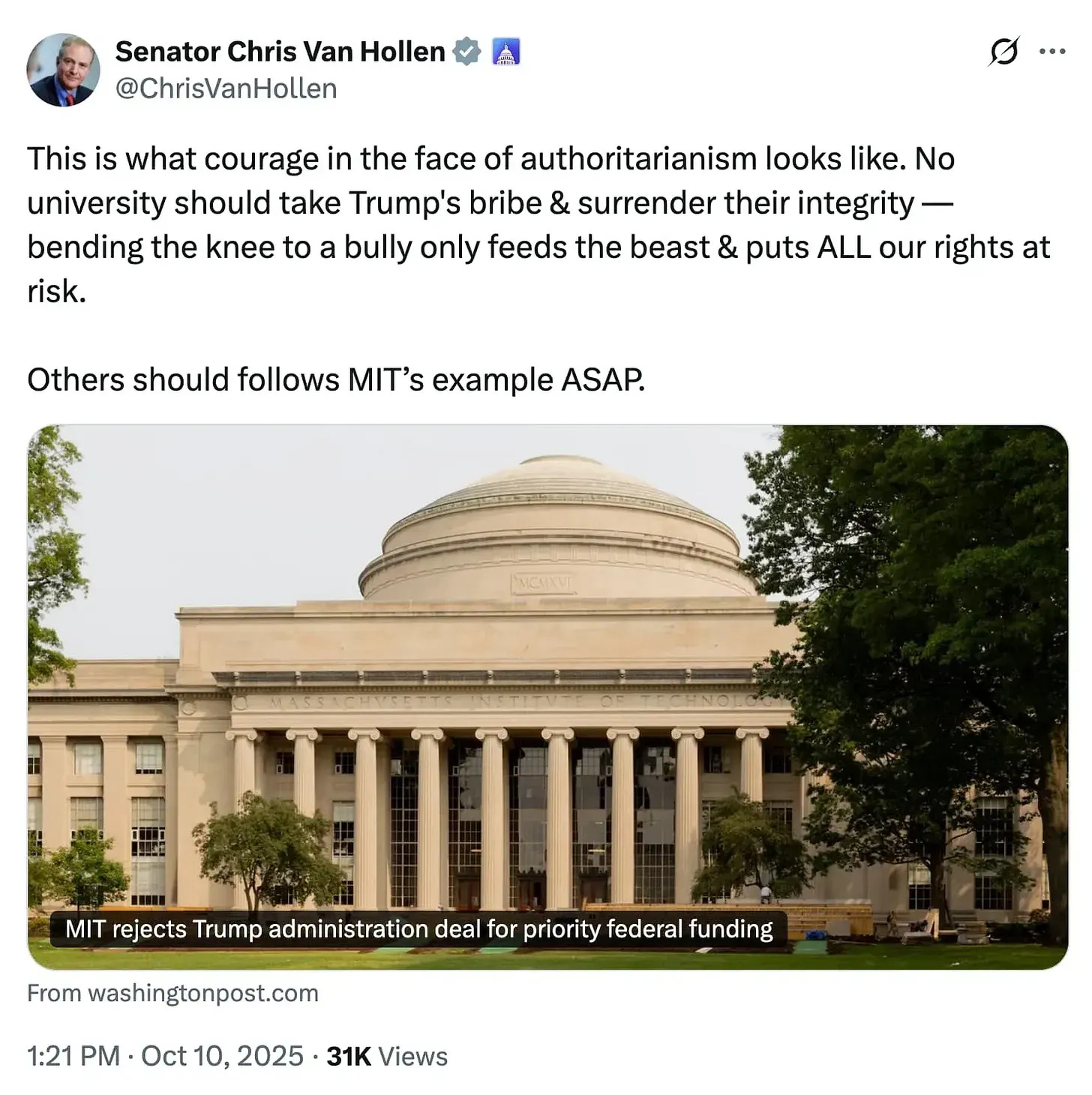Early barometer for CD6
Mendoza has momentum … Project Red, White, and Blue? … And the FEC loves 90210.
There is a clear frontrunner in the race to challenge Tucson Congressman Juan Ciscomani for his seat next year in Congressional District 6.
Campaign finance reports show former Marine JoAnna Mendoza collected more contributions in July, August and September than her would-be rival, with more than $696,000 going into her campaign war chest compared to the roughly $613,000 Ciscomani took in during the same period.
Again, we are still in the early stages of the race, and there’s still time for other Democrats to jump in. But Mendoza’s fundraising prowess and roster of endorsements have already thinned out what was shaping up to be a crowded Democratic primary.
Earlier this year, immigration attorney Mo Goldman, engineer Chris Donat, U.S. Army veteran Aiden Swallow, and former FBI agent Johnathan Buma all flirted with running against the two-term Congressman next year. But each has since bowed out of the race.
The only other remaining Democrat in the race, Samantha Severson, confirmed she hasn’t reached the threshold to report donations to the Federal Election Commission.
The district, known as Congressional District 2 before the boundaries changed, has always been politically competitive. It was Democrat Gabrielle Giiffords’ district, then Democrat Ron Barber served for nearly two terms, then Republican Martha McSally controlled the district after winning in 2014, then Democrat Ann Kirkpatrick took it back when McSally ran for Senate, and Ciscomani took over when Kirkpatrick retired.

Still, fundraising is only one metric of success in a complicated race that’s just warming up.
And while Mendoza is dominating the Democratic primary, Ciscomani still had nearly $2.4 million in the bank at the end of September, compared to the $950,000 that Mendoza had in her checking account.
With no primary challenger and solid name-recognition in the district, Ciscomani’s “burn rate” — how much you spend versus take in each quarter — is significantly lower than Mendoza’s.
His campaign spent about 33% of what it raised in the third quarter on campaign expenses, compared to the 48% that Mendoza spent during the same period.
This should not be much of a surprise, considering the district spans five counties and Mendoza still needs to build her profile and win the Democratic primary. Banking a massive war chest for the general election isn’t a solid strategy if you don’t win the primary.
A little help from friends
While they are neck and neck in terms of raising funds this quarter, Ciscomani benefits from being a two-term incumbent when it comes to bringing in financial contributions.
Through the Ciscomani Victory Fund and other joint fundraising committees, including U.S. House Speaker Mike Johnson’s Grow the Majority fundraising committee, Ciscomani for Congress brought in nearly $1.2 million this year.
Grow the Majority alone has given Ciscomani’s campaign $426,000 in this cycle, signaling that keeping the seat in GOP hands is a top priority for national Republicans.
Political action committees are also deeply invested in the CD6 race, with Ciscomani bringing in more than $230,000 in PAC money this quarter and reporting $895,0000 so far this year.
By comparison, Mendoza took in $84,000 in PAC contributions this cycle and $142,000 for the year.
To be fair, this isn’t an apples-to-apples comparison.
As an incumbent, Ciscomani benefits from existing joint fundraising committees and ties to a deep donor base that has given to his campaign over the last two campaign cycles. And since there is no primary challenge for his third term, he benefits from the Republican Party as well as House leadership groups, which won’t fund candidates that face a primary challenge until after the primary.
Mendoza doesn’t have that advantage.
The Democratic Congressional Campaign Committee has identified Ciscomani as vulnerable in the next election cycle, but they are unlikely to open their wallets — and neither will some national Democratic groups with deep pockets — until after the primary next summer.
Which isn’t to say that Democratic groups won’t stop their ongoing efforts to criticize Ciscomani at every turn.
Still, there are miles to go before the November 2026 election.
And we’ve seen our share of candidates win races without having the biggest war chest. In a swing district like CD6, public sentiment often plays an outsized role in deciding close elections.
We will close with the eternal advice that political consultant James Carville offered more than 30 years ago that still rings true today: “It’s the economy, stupid.”
In other words, it may be whether voters can afford a cheeseburger that decides the election, not the candidates’ war chests.
During the height of the Project Blue 1.0 fight, the developers tried to convince skeptical residents that they would use less water because they were building a traditional data center, not specifically for AI.
On Wednesday, the U.S. Air Force announced that Tucson’s own Davis-Monthan Air Force Base was one of five bases that would be open to private developers looking to build AI-focused data centers.
What we’re calling “Project Red, White and Blue” is part of a $500 billion Trump administration initiative with OpenAI, Oracle, and SoftBank to expand AI infrastructure in the United States.
Per the 96-page request for proposals, the land could be made available for long-term leases, but each company would have to secure its own water and power locally.
“Any and all utilities including, but not limited to power and water, and all services necessary for the Project shall be obtained and provided for by the Potential Lessee(s), at its sole cost and expense,” the document reads.
It’s still very early in the process — and maybe D-M won’t draw interest from the big three AI giants — but what’s almost certain is that the city of Tucson won’t be providing water in any scenario.
Generally speaking, Tucson Water can’t be forced to sell water directly to anyone, including the federal government.
The city does not provide water to D-M; instead, the base pumps its own water from the aquifer.
On paper, the Groundwater Management Act would require D-M to get permission from the Arizona Department of Water Resources if it wanted to pump significantly more water from the Tucson aquifer.
We asked ADWR for comment, but they didn’t get back to us on Thursday. To be fair, it isn’t a simple question — the act does have some loopholes for industrial use.
As most of you know by now, we use our weekly verticals to dive deep into water policy, education and artificial intelligence.
If you’re not subscribed yet, today’s a good day to catch up!
Will the UA stand up or sit down?
We’re pretty sure the top officials at the University of Arizona have been popping antacids for the past two weeks.
They’ve got a big choice to make: Sign a deal with the Trump administration and get VIP access to federal funding, or reject the deal and risk getting on Trump’s “naughty” list.
Students have been raising a ruckus and faculty are pushing UA administrators to tell Trump to take a hike.
The deadline is approaching fast, and four universities already turned down the deal.
In this week’s Education Agenda, we break down the decision UA officials have to make and check in on how other universities are handling the dilemma.
The 32-hour workweek
It’s clear that AI is going to dramatically change the U.S. workforce.
But nobody knows exactly how that’s going to play out.
U.S. Sen. Bernie Sanders released a video warning that 100 million working-class jobs in the U.S. are under threat of being wiped out because of AI and robotics.
Scary, right? Luckily, our AI expert, Adi, spends his day thinking about this type of thing.
In this week’s AI Agenda, he dove into the history of the workweek and asks the question: What if AI actually helped the workforce, instead of destroying it?
Could we all end up with a 32-hour workweek?
The Gail Griffin Decoder Ring
Rep. Gail Griffin is one of the most prolific writers of press releases at the Arizona Legislature.
That’s left quite a track record by the go-to lawmaker for state water regulations, just as Arizona prepares to go under the federal microscope.
Like it or not, the Queen Bee of water policy (who once tried to send a memo to the president saying “salt cedar trees are the main cause of Colorado River water declines”) is the public face of Arizona’s water policymaking.
And that might not be the best look.
In this week’s Water Agenda, our water guru Christian takes another stab at understanding Griffin and the water policies she’s bragged about for the past year.
It’s refreshing to see people keep their sense of humor, especially when they’re buried within a massive bureaucracy.
When we were going through Federal Elections Commission data yesterday, we happened to notice that somebody at the FEC added a dash of levity to the mind-numbing work of searching campaign finance reports.
Check out the ZIP code they chose. (Definitely a GenXer, right?)










An Emeritus Professor of Pediatrics at the UA College of Medicine and have already expressed my opinion to NOT accept the bribe attempt of Trump for the University of Arizona to both the UA President and Governor Hobbs! You do not do “deals” with the devil!! Another comment on the worst Congressman to represent me in my 42 years living in Tucson. He voted to take away his constituents MedicAid, he voted to take away his constituents subsidies for Obamacare, and last but not least voted to take away food from poor children in District 6! Then, when the blowback started this ChickenShit made a public comment asking Republican Senators to reverse his vote! This chickenshit clown has never held a town hall meeting in Tucson since he took office in early January 2021!!!
Excellent coverage!